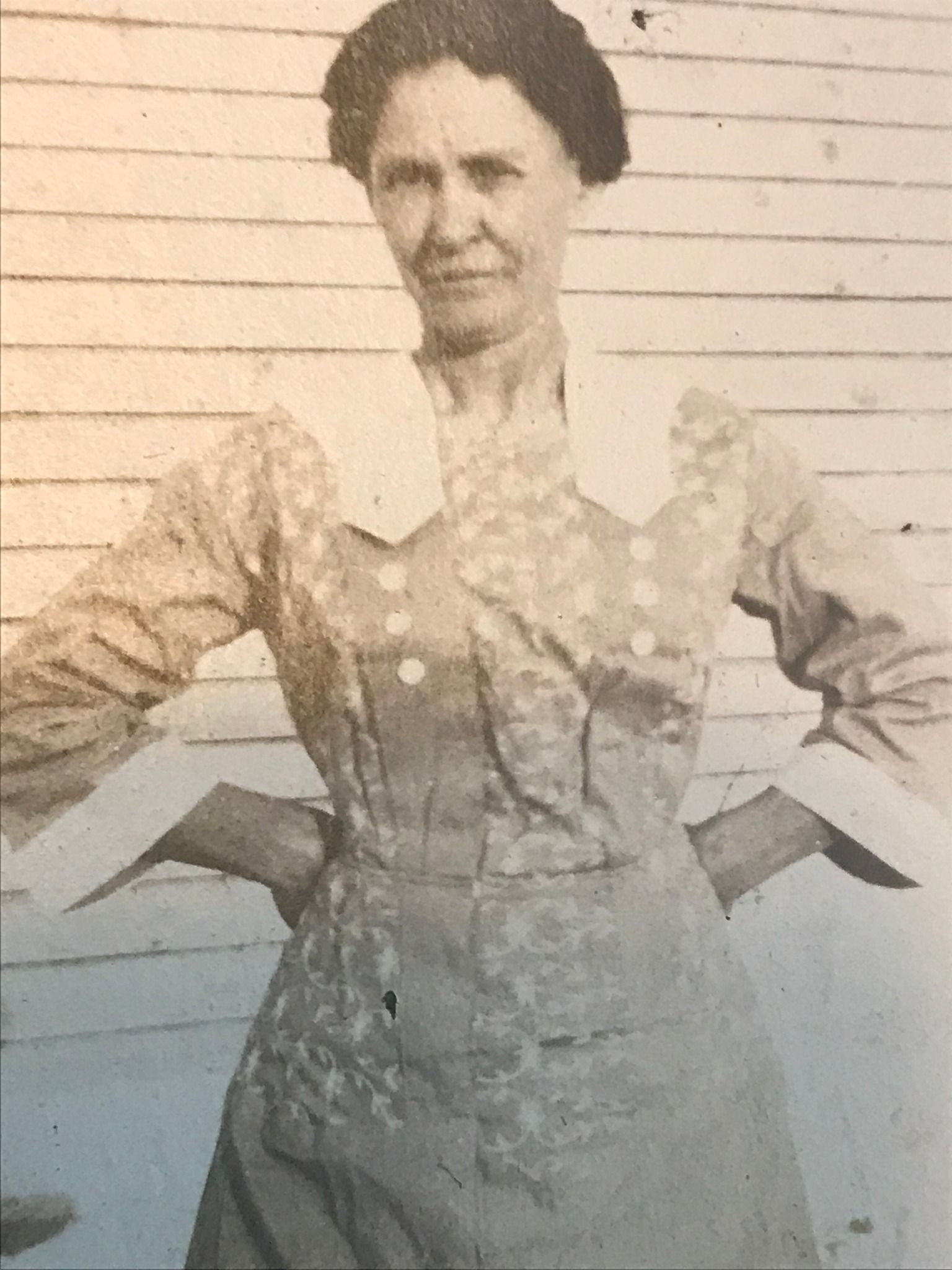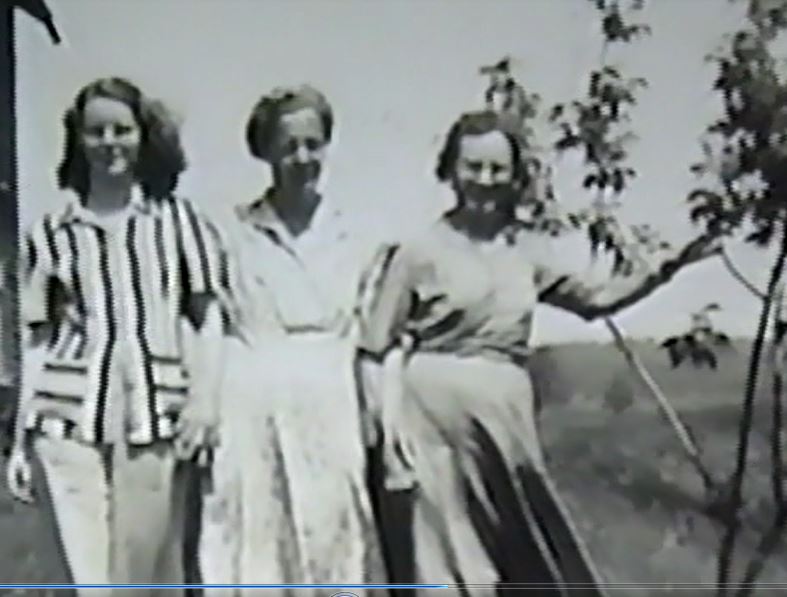Circa: Grindstone Island late 1930’s – 1940’s
About halfway between my home and the Lower Schoolhouse on Grindstone Island, lived my Grandmother Dano (Ordelia Graham Dano). She was my maternal grandmother and the mother of 12 children. Her home was a small, two-story wooden home, complete with two stoves; one was a heater and the other one was a kitchen type stove with cast iron top with griddles. A few cupboards held dishes, many of them old and were her treasures. The house also included a basement and one bedroom downstairs for Grams. The front door faced the road and I never saw it open; we always used the back door that faced the barn. The outside of the house was now the familiar faded brown of weathered wood.

There were two outer buildings on the property; a two-hole outhouse (outie), and a large building that was used as a woodshed. There were flower beds around the house, too. I don’t remember the kinds of flowers that grew there, but I do remember on the shady side of the woodshed was a stand of rhubarb, and on the west side, a patch of raspberries. There was very little wood in the woodshed, and it was mostly pine. Pine burned quickly, was easy to light, and was perfect for a quick, hot, fire.
A portion of the woodshed was dedicated to Grandma’s canning and bottling factory. In one corner was a collection of empty dark glass bottles with necks, a bench, a box of metal bottle caps, and a bottle capper. The empty bottles were placed bottom up, outside, drying in the sun, and ready to be refilled with what she called beer. Homemade in wooden tubs covered with wood covers, my brother Milton and I assisted her many times with the bottling and capping of her home brew. After bottling and capping, they were carried to the cellar for storage.
Directly north of the house was the garden. I believe at one time Grandma’s garden was part of a pond that was drained, because the soil was so dark and rich. Even without fertilizer, the vegetables grew well. Between the house and the outie was a wood pile with large cut pieces of oak. Some of the wood was stacked and split, but a large pile of wood remained, with a large ax embedded in the wood. You never saw that axe just lying just on the ground.
When you entered the back door of her home, to your right was the pantry that contained flour, beans, and other items purchased from a store in Clayton. Other store-bought items in the pantry were sugar and canned goods. The pantry also included her own jams, jellies, and raw honey from the hives on the south side of her property.
Next to the pantry were stairs going up to the second floor. I don’t remember stairs inside the house leading down to the basement, you had to access it by using the outside stairs. In the kitchen, there was a small table and chairs, and an old ice box that I never remember having any ice. Wall hooks held some heavy jackets. The living room held a scatter rug, a rocking chair, couch, and a large wood-burning round oak stove. Small tables in the room held plant vines in glassware that were starting to take root. I never spent the night at Grandma’s house – I would have been too afraid!
Some 200 yards away from Grandma’s place was the larger house on the Dano Farm. Why Grandma lived in the smaller house and not at the big house, I don’t know and never thought to ask. The larger house was where she had lived with my late grandfather and raised her large family. This home had running water, an indoor bathroom, electric lights, central heating – a rather modern home, compared to the small one that she lived in. My mother’s brother Rawdon lived with his wife, Olive, in the larger home. Together, they operated the farm; milking, harvesting the crops, repairing the buildings, fences, and machinery.
There was no lawn on this property. My guess is that her son cut the hay that grew around her home and created a path from the road to a small gate that led to the back door of the house. The wooden gate was built between two large oak trees and fastened to the trees with a leather harness. The path continued from her house to the barn and was well-worn. I can’t remember where the well was located, but I do remember that inside the kitchen was a hand pump in the sink. It was connected to a cistern in the basement, which was filled with rainwater that was caught from the roof.

I knew that this little house had been moved to its present site many years before. Originally, it had come from the Pettit Farm. This was a small farm about a half mile away and where her brother William Graham now lived. As time would reveal, on this farm only the barn, the well, and pump would remain, a few larger stones, as well as a hole where the basement had once been. Many years later, I would visit the barn and discover a beam inside it, with “Bailing Hay S. Slate, W. Rusho, A. Dano Dec 1901,” written on it in black paint.
Grandma knew every berry patch within a half mile of her home; raspberries, strawberries, blackberries, and near the old Pettit Farm, blueberries grew. Blackberries were the worst to pick because the bushes had thorns that were long and sharp. Hickory trees grew in the fields and apple trees were next door. Her fruit press was in one of the farm buildings and she always kept a supply of cider handy. Looking back, I now realize that my grandmother loved being alone and doing things her own way. She had raised a large family and her reward was now having this simple freedom and independence.
Buckwheat grew in the fields just west of the barn. A homemade smoker near the larger house provided bacon and hams. In a couple of years, I would supply her with eel skins that were ready for her smoker. The smoker consisted of a steel barrel with a hole near the bottom and about ten feet of stove pipe. From the barrel to the stone oven about ten feet away, the eels hung on bent nails hooked to the edge of the barrel. The smoker was fired using hickory wood chips. I would catch the eels, skin them, and give them to my grandmother to smoke them. I never developed a taste for smoked eel, but my grandmother loved them. In my family’s boathouse, there were nails driven into the stairs where I hooked the head on the nail and skinned the eels.
I mentioned that Grandma’s house was halfway between the school and my home. School was over at 4 pm and after the usual goodbyes to my classmates at the turn for the Lower Town Landing, I would walk towards home with an empty lunchbox and a growling stomach to match. At this point in my journey, I could almost taste the goodies in Grandma’s kitchen. Reaching and unfastening her gate, dying with hunger as I reached her door. The smell of fresh baking filled the air and usually included oatmeal cookies – thick, warm, and waiting to be eaten.
The real treat was her homemade bread, a heavy bread made differently from my mother’s lighter, fluffier, bread. Gram’s bread was tight, with very few air bubbles and with a thick, heavy, crust. When spread with creamy butter and buckwheat honey – man oh man – it was perfection! I would continue my journey home with a full stomach, only to be hungry again in a half hour and ready for dinner!
In her older age, my grandmother moved to our farmhouse on the Rusho Farm. Here she had running water, indoor plumbing, and someone else to split the wood and carry it in for her. Before a fire destroyed her little home, I never passed by it without great memories.
By Manley L. Rusho
Manley Rusho was born on Grindstone Island nine+ decades ago. Back in 2021, Manley started sharing his memories with TI Life. (Manley Rusho articles) This Editor and his many friends send our very best as we know he is not able to return this summer, but we want him to know summer and the regular and new groups of River Rats have arrived on Grindstone Island and the River . We also want him to know "we are thinking of you Manley. As always, we thank you, most sincerely, for sharing - as the life and times on Grindstone Island are special and should never be forgotten."
Posted in: Volume 18, Issue 6, June 2023, History, People, Places
Please click here if you are unable to post your comment.
